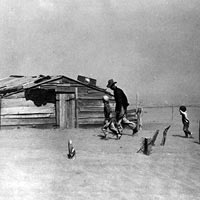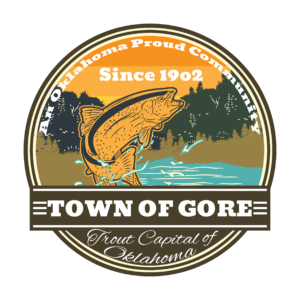Click photos to view
1924 Christmas Eve
Woodrow Dickerson Station
Dr. William Wallace Campbell
Campbell changed Gore
Lower Illinois River
Gore Stockyard
Gore-School
Gore Old Rock Station
Gore Mercantile Hays Store
Gore Depot Circa
Gore Fire
Esther Steamship
Dedication of Service Monument
Commercial Hotel Gore
Businessmen in front of Majestic Hotel
Ensminger Home
Summers Ferry
Senator Thomas P. Gore
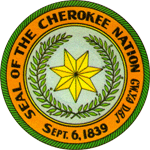
The settlement which became known as Gore reaches far back into the history of the area. Gore appeared on the earliest French maps of Louisiana Territory prepared by a French explorer, Guillaume de Lille in 1718 as Mentos or “Les Mentous.” Before the Cherokee Indians came to the area, two partners operated a salt works on Saline Creek, seven miles northeast of the present town, and at times more than a hundred huge kettles were used for boiling salt water. The salt was shipped down river to New Orleans. When the Cherokees came into the Territory, Walter Webbers, a prominent Cherokee, was given this district as his allotment and he took over the salt works.
Walter Webber built his trading post just below the falls on the Arkansas River. In 1806 the falls were reported to be six feet in height and during low water the falls were impassible except for smaller boats which could be carried around the barrier. Sometime after Walter Webber died, William L. Holt, an Englishman, established his home on the eastern bank of the Arkansas River near the falls. Here he farmed and established a trading post which was called Holt’s Landing. William Holt and his wife, a Cherokee named Nellie Miller, raised a family of nine. His descendants still live on the land that he settled and the town of Gore was laid out on some of that land.
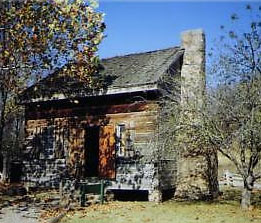
On the banks of the Arkansas River south of the present site of Gore is the Illinois Camp Grounds. Here was the site of the capital for the “old Settlers” or the Cherokees which became known as the Cherokees west. John Holly, a Cherokee Chief, built his home on Deep Branch near the capital. He helped establish a school at the place which was known as Council Hill. A council house, called Tahlonteeskee, was built also. Tribal courts were held at this site until 1839 when the Cherokees West were united with the Cherokees that had been forced out of the Eastern part of the United States. It was at Tahlonteeskee, October 31, 1831 that Sam Houston was adopted into the tribe. That adoption read: “Resolved by the National committee and Council in General Council Convened, That in consideration of his former acquaintance with, and services rendered to the Cherokees and his present disposition to improve their condition and benefit their circumstances, and our confidence in his integrity and honor, if he should remain among us, we do solemnly, firmly, and irrevocably grant to Samuel Houston forever, all the rights, privileges, and immunities of a citizen of the Cherokee Nation. Signed, Walter Webber, President, William Thornton, Clerk, Aaron Price, Speaker of Council, John Brown, Clerk of Council and approved by John Jolly.” Houston lived among the Indians, took a wife, and remained for some time.
William Holt’s store at Holt’s Landing was operated until the Civil War. Shipments were made to the landing by boats from Forth Smith that regularly traveled the river during high water. Most of the goods were hauled by the Mary D, piloted by Captain Blackely. Another boat was the Jennie Mae. When the boats returned to Fort Smith, they would haul cotton corn, and seeds. Mr. Holt was killed on the sandbar opposite his home in the battle of Webbers Falls on April 25, 1863 when the forces of Colonel William A. Philips from Fort Gibson attacked the forces at Webbers falls.
Following the Civil War which divided families even in the Indian Territory, many people displaced from the South began moving into the Territory and small settlements began to grow. So would the settlements of Webbers Falls and Gore grow.
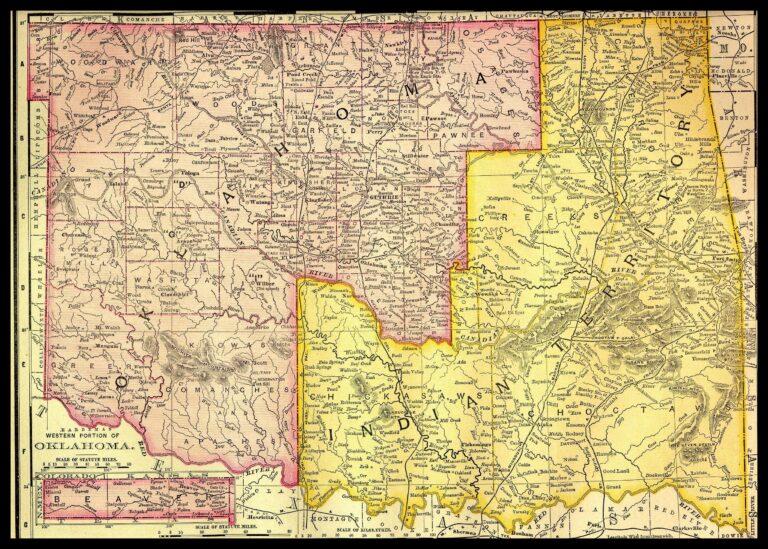
In 1884 a Sunday school was organized in the settlement near the eastern side of the Arkansas River. It was organized and called the Illinois Town Sunday School. The settlement had become known as Illinois, probably because it was in the district of the Cherokee Nation known as the Illinois District. The Methodist Episcopal Church South had sent missionaries into the Indian Territory early and here in the settlement a small church was built and it was also used as a school.
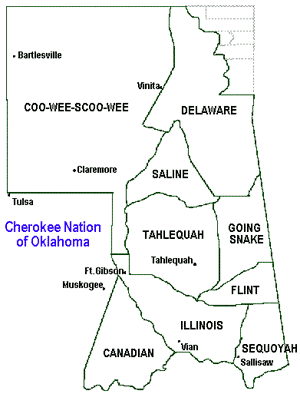
The settlement of Illinois Town was further established by the railroad. In November of 1885 the Kansas and Arkansas Valley Railway was incorporated under the general laws of Arkansas. Work was begun on a stretch of railroad beginning at the Arkansas-Oklahoma State Line west of Van Buren, Arkansas to Wagoner, Oklahoma. This stretch was finished in 1888. The stretch from Wagoner to the Oklahoma-Kansas state line was finished in 1889, connecting Wagoner to Coffeyville, Kansas.

In 1890 this railroad was leased to the Saint Louis, Iron Mountain and Southern Railway Company and was sold to, what was called by the locals as, the Iron Mountain Railroad, in 1909. All along this railroad route, small settlements began to form and it wasn’t long until the settlement that has become the town of Gore began growing. At first the trains would stop closer to the Illinois River where they could get good clean water. A tower was built and for some time the train would stop there. It was called Illinois Station. People could board the train there or at the stop in the settlement. After a while the train only stopped in the settlement.
Dr. William Wallace Campbell, William Holt’s grandson, established his home on the eastern banks of the Arkansas River just below the falls. His medical office was at Webbers Falls, but he served the area for miles around. Campbell was born in the Saline District of the Cherokee Nation in 1836. His father was John Campbell and his mother was Eliza Holt, the daughter of William and Eliza Miller Holt. Both Campbell’s parents were from Tennessee. Dr. Campbell had attended the Cherokee Male Seminary and graduated from the University of Nashville, Tennessee in 1861. He served during the Civil War as a Confederate Surgeon.
In the early days the only way to cross the river was to ford it, and when the river was too high to ford, travelers would have to use the ferry that was owned and operated by Dr. Campbell. Two ferries, a steam operated one and a cable one, were operated by Dr. Campbell and Judge Lynch of Webbers Falls. Judge Lynch ran the Webbers Falls side of the ferry while Campbell owned the eastern side rights. After Judge Lynch’s death, his wife and Dr. Campbell sold their interest in the ferry business to David S. and Charlie Summers, who operated the ferries until the bridge was built in 1923.
In 1888 a depot was built and on August 10, 1888, the post office was established at the Campbell Store in Illinois Station. David M. Barrick was the first postmaster. Letters came both addressed to Illinois Station and Campbell, Indian Territory and many came with both addresses on them. Also, in 1888, Andrew James Boyd and his family, moved to Illinois Station from Arkansas. Andrew was a Methodist Missionary and he had brought with him two carloads of lumber with which to build a Methodist Church. The church was built and Mr. Boyd became the first minister. He was appointed by the Indian Missionary Conference to serve the Webbers Falls and Gore Circuit. Mr. Boyd later moved to Webbers Falls.

From the Fort Smith Weekly Elevator, Friday, June 21, 1889: “ILLINOIS STATION: This is virtually a branch of Webbers Falls on the Kansas and Arkansas Valley Railroad, on the opposite side of the Arkansas River, and is about one-and-a-half miles from the falls. Mr. J.W. Hayes keeps a management of J.E. Hays, formerly of this place (Webbers Falls). Lynch and Campbell also have a general merchandise establishment and R. Campbell has another establishment where he keeps drugs as well as other merchandise. Here also is the May’s Hotel, a branch of the Southern Hotel at the Falls, owned by Mr. McDaniel and presided over by two of his daughters. Reverend Mr. Boyd has erected a church here also, in which a good school is conducted…”
From the Weekly Phoenix, Muskogee, March 9, 1893: “On the Illinois side: Dr. W.W. Campbell, for whom the Post Office was named lives in a fine residence just south of the railroad. Further east is the business house of Thomas Carlisle. Judge Wallace Ratley’s live adjacent. On the north side of the track is the fine large mercantile house and gin of the Hayes estate, with J.E. Hayes as manager…Back of this are snug cottages of J.E. Hayes, Mr. Boulineau, and Mr. A.K. Berry, notary, with his sister. Miss Pearl. A good hotel is kept by Mrs. Carrie Hildebrand; while east of the depot, Mr. Ben Hayes and family reside. This composes about all of the immediate town.”
Mrs. Nannie E. Campbell Winn, the daughter of Dr. Campbell told the following story of the per capital payment to the Cherokee Indians in the summer of 1894 published in the Muskogee Phoenix, April 11, 1976 and written by Marguerite McFadden, a granddaughter of Reverend Andrew Boyd. “On July 20, a crowd numbering thousands flocked to Webbers falls, and on Saturday and Sunday the town and surrounding forest and prairie were alive with visitors, waiting for the distribution of funds, which commenced at 9 o’clock on Monday morning, July 22, 1894. The payment continued for four days.”… “The crowds were coming into the area from all directions and by all manner of conveyances. Wagons drawn by mules and horses, horseback riders, buggies, and people on foot came in by the thousands.” Mrs. Winn stated that many of the people came by train and the traffic was so heavy on the ferry that it was loaded to capacity time and time again. She stated that her father had taken in $500.00 per day for the duration of the payment.
The better farmland was on the Webbers Falls side of the river. Potatoes were a choice crop during this period of time and the train was the best way of getting goods to market. This provided another good season for the ferry.
By 1897 when the original survey was made, there were approximately twenty dwellings in the town. There were by this time, three stores, a cotton gin, two hotels and a Methodist Church.
In 1898, Dr. John A. Eichling established his medical practice in Campbell, Indian Territory. He had graduated from Barnes Medical College in St. Louis. He was born in Indiana and had taught school there. In 1899 he was the owner of the Illinois Drug Company from which he practiced and provided medicines. Also that year he went back to Indiana and brought his new bride to Campbell.
Campbell is listed in Polk’s Indian Territory Gazetteer and Business Directory for 1902-1903. The following was included: Population 250. On the Arkansas River and on the St Louis, Iron Mountain, and Southern Railway, in the Cherokee Nation 47 miles northwest of Fort Smith, Arkansas, twenty and three/fourths miles from Sallisaw and twenty-one and one/fourth from Fort Gibson, both of which latter places afford banking facilities. Has Christian and Methodist churches. Telephone connection. Esp., Pacific. Tel., W.U. Wm Halloway, Postmaster; John Brown, barber; R.B. Carlile, general store; F.L. Clark, livestock: Mrs. J.A. Gilliland, propr. Commercial Hotel; A. Crofford, physician; J.A. Eichling, physician; G.B. Foreman and Co, blacksmiths; Gilliland Bros., general store; Mrs. J.A. Gilliland, propr. Commercial Hotel; D.S. Hays & Co., general store; J.T. Holman, carpenter; J.M. Jones, drugs; Hiram Linder, notary pubic; J.R. McCants, hotel, –Pillings, rr and express agent; T.L. Savy, aft. Mo Pac Ry; McKinney Smith, stage line; H.V. Snider, hotel; Rev. J.F. Weems.
On Wednesday, January 29, 1902 in the Records of the United States Court, Indian Territory, Northern District, at Muskogee, forty-two qualified voters of the Indian Territory sought for the settlement of Campbell, Indian Territory to be incorporated. The postmaster William Halloway was the only individual for the town of Gore. In the weekly newspaper of Webbers Falls known as The Monitor, on Friday, May 24, 1902 this was attested. In the Campbell chat column it was reported that “The petition for incorporation was signed by 45 men – All there are in town.”
During this period of time the mercantile establishments faced the railroad. On the eastern side of the railroad on North Railroad Street was located the stockyard. Ranches from all over the area brought their cattle here to load on the trains. The small town of Campbell which was laid out in 1903 was bustling with new life. The Campbell Register, the first newspaper to be published in the town of Campbell was edited by Fred Bertram Eichling, the brother of Dr. John A. Eichling. Fred Eichling received his law degree in Indianapolis, Indiana and moved to Porum in 1904 and from there to Campbell. The first edition was September 14, 1906. It was a paper consisting of four pages. Seth K. Cordon later published a weekly newspaper in Campbell which was called The Citizen. It was still in publication at the time of Mr. Cordon’s untimely death in 1912.
In 1908, Fred Eichling established his law office in the town of Gore and handled real estate. His advertisement read: “GREETING: We take pleasure in presenting to the public the “liveliest town on the map” located in the rich Arkansas and Illinois River country on the trunk line of the Iron Mountain Road, Kansas and Arkansas Valley Division. History credits the Cherokee tribe of Indians with appropriately naming the different Sections of their beautiful country according to its location and condition. This same tribe of Indians christened the beautiful valley of some 100,000 acres of the finest agricultural land in the Indian Territory, Illinois, and the thriving little town of Campbell is located in the very heart of this valley just one half mile north of the Arkansas River and two miles west of the Illinois, with the majestic range of mountains containing rich mineral and timber, towering to the northward; nature has been particularly kind to this locality. Splendid drinking water is found at a depth ranging from twenty-five to sixty feet. One mountain stream, the Illinois, fed by perpetual springs, winds its way the year around to the Arkansas River; this with the Arkansas River furnishes an unlimited supply of water for factories; the rich land adjacent to the little city of Campbell is wholly dependent upon Campbell for supplies.
The timber is another item that is another important feature of the valley and the shipment of walnut logs is bringing in a large amount of money. A saw mill near the town is furnishing all the rough lumber used in building, and at a much cheaper rate than it can be purchased in other markets.
As to the railroad facilities, Campbell is very fortunate as it is situated on the trunk line of the Iron Mountain Road between Little Rock, Arkansas and Coffeyville, Kansas.
Campbell now has one bank, just incorporated September I, 1906, three general stores, one drug store, billiard and pool hall, two good hotels, two cotton gins, two blacksmith shops, one barbershop, a meat market, two restaurants, livery stable, millinery store and two physicians, saw mill and good stone quarry near town; a $10,000 brick building is now under construction to be occupied by the bank and three general stores and several brick and stone buildings will be built in the near future.
Investors from New York City are here now looking to put a bridge across the Arkansas River costing nearly $150,000; We shipped from here last year cotton, potatoes, corn, and tons of hay. Nine-tenths of our agricultural land is yet undeveloped and our mineral land is as nature put it; still can be seen the turkey, deer, wolf, and wildcat, but they are rapidly disappearing by the hand of civilization and the next few years will find them almost driven out of the country; fruit grows in abundance where it has been tried, one man taking the prize on peaches at the World’s Fair at St. Louis, thirty-six of his peaches making a bushel. The swift Illinois River furnishes an unlimited supply of waterpower.
The rush is on! Wide awake men are flocking to the Indian Territory by the thousands! Lands that for thirty or forty years have been used only for grazing purposes are being converted into farms and the yield of wheat, oats, millet, maize, Indian corn, melons, cotton, potatoes, and vegetables is amazing. Veritable fortunes have been amassed in a few years by those who settled here, and no one is more surprised at the result than themselves.
Eichling Realty & Insurance Company has farms to sell, lease, or rent. Every tract of land handled by us is carefully examined and the result is every customer is our friend.”
In 1907, Oklahoma became a state and the town became Campbell, Oklahoma. Campbell was growing and the citizens felt the need to call a bond to build a new schoolhouse. Dr. J.W. Sosbee, Riley Cleveland, and Dr. John A. Eichling were members of the school board, and both Dr. Sosbee and Dr. Eichling gave land upon which the school would be built. The cornerstone was laid in 1908 and the building was ready for the 1909 school year. It was a modern two-story brick building heated by coal stoves. The day the school opened the children marched from the old schoolhouse, which was also the Methodist Church, to the new school. Dr. John A. Eichling gave a lot also to the Methodist Church in April of 1909 and a new church building was soon constructed.
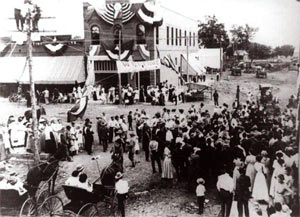
In the early hours of April 4, 1909, a fire was discovered in the business section of the town and nearly every building of importance was burned. The story was carried in the Webbers Falls Record on April 9, 1909. It read: “The business section of our sister city, Campbell, was practically wiped out by fire early Sunday morning. The building occupied by the pool hall was discovered to be on fire about 4 a.m. and it quickly spread to adjoining buildings despite the heroic efforts of Campbell’s citizens to check it. Besides the pool hall, Dr. Sosbee’s Office, Jon Sour’s candy kitchen, Lyon’s restaurant, the brick block occupied by the bank, Wynn’s pharmacy, Ingram’s general store, Gilliland-Hayes Merc. Co, the post office, a feed store and the Dyke Bros. lumber yard, the Gilliland-Hayes cotton gin and four cottages were burned. The bank officials were able to save all their books, securities, cash and practically all the furniture, and they were opening business Monday morning in another building. The contents of the post office were also moved as well as some of the contents of the other buildings. The brick block will be rebuilt immediately and occupied by the same firms that burned out. We understand that Gilliland-Hayes have purchased the Grant Rasor store and are now conducting business at that stand. Mr. Wynn has purchased the Dr. Eichling drug store where he will continue business until the new brick block is completed.”
In the Oklahoma Gazetteer for 1909 Campbell boasted: Population, 350. An incorporated town on the Arkansas River and on the St. L, I.M. & S. Ry., in Sequoyah County, 47 miles northwest of Fort Smith, Ark., 22 from Sallisaw, the county seat, and 1 1/2 from Webbers Falls, the nearest banking point. Tel., W.U. Exp., Pacific. Telephone connection. J.W. Parker, Postmaster. Breedlove Bros, livery; John Brown, barber; W.H. Bryson, flourmills; S.P. Butts, painter; Campbell Cottonwood lumber co; R.B, Carlisle, live stock; W.F. Davis, carpenter; Dyke Bros, lumber; G.W. Edwards propr. Hotel Commercial; Charles Eichling, carpenter; Dr. J.A. Eichling, drugs; Farmers Bank of Illinois (cap $10,000), I.H, Nakdimen, pres, J.F. Hamilton, cashier; George B. Foreman, undertaker’s goods, paints, insurance agent and notary; Ben Gilliland, barber; Gilliland-Hayes Mercantile Co, general store; J.F. Hamilton, cashier Farmers’ Bank of Illinois; Henry Bros., billiard hall; G.W. Edwards propr., Hotel Commercial; W.J. Smith propr., Hotel Majestic; John Hughs, restaurant; L.S. Ingram, general store; H. V. Linder, justice of peace; H.M. Lyon, grocer; B.F. Newton, blacksmith; T.H. Okelley, shoemaker; Parker and Cameron, meats; Pierce Company, grocers; Pioneer Tel & Co.; Planters Cotton & Ginning Co., Riley Cleveland mngr.; Grant Rasor, hardware; W. Rozell, R.agt; W.J. Smith, propr., Hotel Majestic; J.W. Sosbee, physician; J.G. Terrill, livestock: J.W. Tyner, justice of peace; Rev, J.F. Weems (Methodist); Western Union Tel. Co.; S.A. Wynn, drugs.
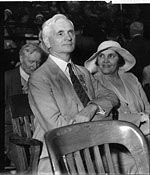
On October 22,1909 the name of the town was officially changed to Gore in honor of Senator Thomas P. Gore. There are several stories as to how the town got its name, but at statehood there just happened to be another Campbell, Oklahoma so Campbell, Sequoyah County, Oklahoma needed a new name. One story told is that the local baseball team needed suits and one of our town’s leaders contacted Senator Gore and asked for a donation to secure the suits and if he chose to help, the name of the town would be changed in his honor. Whatever the reason the town has been called Gore since that time. Thomas Pryor Gore was born in Mississippi in 1870. He was the first blind Senator to enter the United States Senate. In 1901 he moved to Lawton, Oklahoma Territory. He became one of the most eloquent and able thinkers in the two territories on matters of government. Senator Gore died in 1949.
The Farmers Bank of Illinois was the first bank to locate in the present town of Gore. The Nakdimen family of Fort Smith, Arkansas, owned the bank. During the financial crisis of the early 1920’s the bank failed and it wasn’t until many years later that the branch banks of Lake Country and Vian State Bank provided once again banking for the town.
In the early days many people would gather and watch the independent
baseball teams play. The first field was what would now be in front of
Steve Sloan’s home. Waldo Eichling told the story that as a boy, he
would carry water from his home cistern on main street to the field and
sell it for 5 cents a dipper. About 1930 this area was sold and the new
owner wanted it fenced for grazing his cattle. The players had to find a
better place. Several of them put their heads together and decided to
clean up the area that today is the present baseball park. The homes
that had formerly been on the area and had been destroyed in the
disastrous fire of 1909 still had foundations that had to be removed,
Cisterns were scattered all over the seven-lot area. But determined to
have a field to
play upon, the team went to work and filled the
cisterns. Waldo Eichling, second baseman, remembers that an old safe
that had been destroyed in the fire was placed in the cistern nearest
the old second base. Many loads of sand were hauled from the river. This
was in the early thirties and the field has been used ever since. In
the 1950’s the three of the four lots along Main Street were given to
the school by the Nakdimen family. The field was turned around after the
Johnston Family gave some lots to provide a greater playing area.
